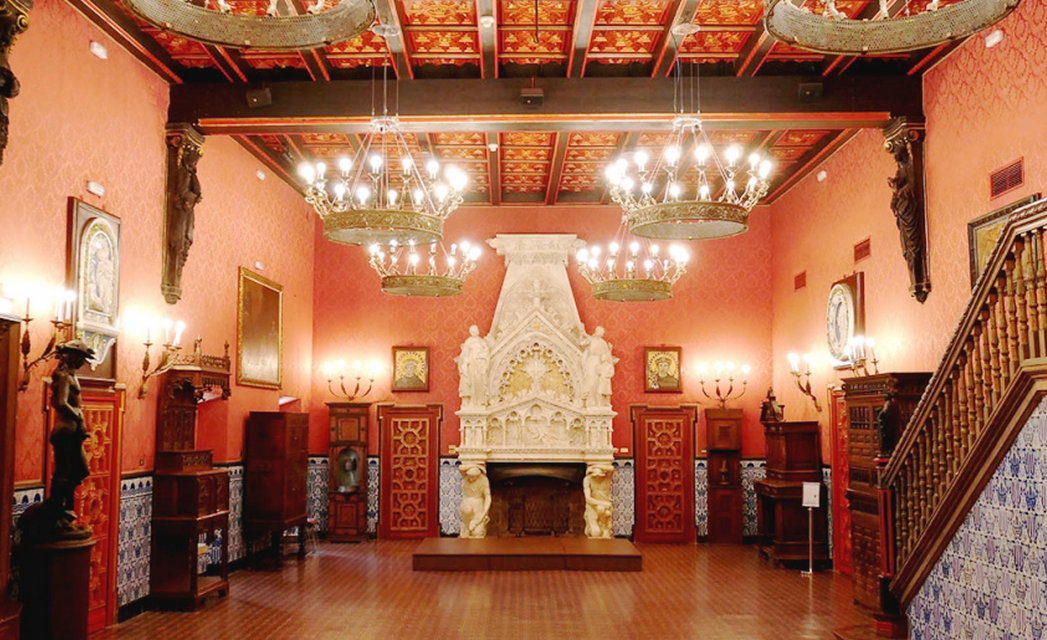The Palau de Maricel is one of the most emblematic buildings in Sitges. Forming part of Maricel’s artistic ensemble, also receives the name of Maricel de Terra as a differentiation from the museum also known as Maricel de Mar.
The Gold Room, the Blue Room, the Chapel Room, the Ship’s Room, Terraces or the Cloister, enjoying a splendid view over the Mediterranean, are the main areas that make up the Palace. With a markedly “Noucentista” style, the different rooms are distinguished by a unique decor stressing its character.
The Palau currently has a triple function: firstly, as a place that holds very important institutional and cultural events of the utmost importance in the civic and cultural life of Sitges, such as concerts, lectures or presentations. Secondly, some of the areas host events of organizations and companies that rent its use, as well as civil marriages. And finally, rooms, terrace and cloisters are accessible by Guided Tours that Museums of Sitges organize every Sunday. During summer months, the program of visits extends to include castanet concerts and dinners under a full moon on their magnificent terraces.
The majestic Gold Room is the space used by Museums of Sitges to organize different academic sessions, such as the seminar about the Art Market, Collections and Museums, the Day of Archaeology of Sitges and the International Symposium on Noucentisme. This same area has witnessed a long list of significant social and cultural events, such as the Meeting of Catalan and Spanish Intellectuals promoted by the Catalan Government in 1981 and various courses of the University Menéndez Pelayo, among many others.
In 1909 the industrialist, philanthropist and collector of American art Charles Deering arrived in Sitges with the help of his friend Ramon Casas. When discovering the Cau Ferrat of Santiago Rusiñol and the beauty of the town, I decided that it was the ideal place to install its art collections. After acquiring the former San Juan Hospital and the fishermen’s houses in the square of the same name, under the technical and artistic direction of Miquel Utrillo, the Maricel Palace was built, an authentic nineteenth-century architectural gem of our town. A guided tour of its spaces will allow us to recall the importance of the figure of Deering, of collecting in the early 20th century, of Miquel Utrillo and Noucentisme.
The Museums of Sitges, entirely dedicated to art and fully linked to the country’s cultural history, offer the opportunity to take a complete tour of the history of art. A journey from ancient art to the contemporary between works of great quality.
The guided tour at the Palau de Maricel invites you to visit its rooms, get to know its history and admire its collections. Built between 1913 and 1918, Maricel Palace is one of Sitcent’s noucentista jewelery and the itinerary examines all the corners of this emblematic building: from the Golden Hall and the Blue Hall to the terraces and the cloister, From where you can see some of the Mediterranean’s pre-eminent views.
From the Romanesque to the Noucentisme, a journey through the history of the art of Catalonia through the Parish of Sant Bartomeu and Santa Tecla. Outside: explanations about the lively history of the bastion, the frigate, the first knights, the vegueries and the transformations of the building. Inside: trails by the credentials, the sarcophagi, the role of Ferré i Bassa, the counter-reform of the sixteenth century and the set of baroque altarpieces. On the first floor: one of the best collections of sacred art in the country, with the Romanesque, Gothic, Renaissance and Baroque images that are part of the collection of Dr. Jesús Pérez-Rosales of the Maricel Museum. And, finally, in the bell tower: spectacular views of Sitges and the Mediterranean from the highest point of the Punta.












